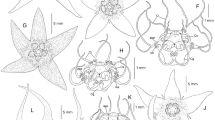Summary
Matelea sartago-diaboli is described from the Río Grande inter-Andean dry valley system of central Bolivia, and compared with the recently described Argentinian endemic M. calchaquina. The new species is illustrated, and its conservation status discussed.

Similar content being viewed by others
References
Atahuachi, M. & Rico, L. (2007). A new species of Acacia (Leguminosae: Mimosoideae) endemic to Bolivia. Kew Bull. 64: 605 – 608.
Dubs, B. (1998). Prodromus Florae Matogrossensis. The botany of Matto Grosso Series B, no. 3. Betrona-Verlag.
Ezcurra, C. (1999). Asclepiadaceae. In: F. O. Zuloaga & O. Morrone (eds), Catálogo de las plantas vasculares de la República Argentina II: 78 – 98. Missouri Botanical Garden Press.
____ & Belgrano, M. J. (2007). A new species and a new combination in Matelea (Apocynaceae, Asclepiadoideae) from Southern South America. Syst. Bot. 32: 856 – 861.
Fontella-Pereira, J., Valente, M. da C., Marquete, N. F. da S. & Ichaso, C. L. F. (2004). Apocináceae-Asclepiadóideas. Observações ecológicas: Reis, A. & Iza, O. B. In: R. Reitz & A. Reis (eds.), Flora Ilustrada Catarinense, Monografia — Ascl. 1 – 250.
Goyder, D. J. (2004a). The identities of Corollonema Schltr., Dactylostelma Schltr. and Metoxypetalum Morillo (Apocynaceae: Asclepiadoideae). Kew Bull. 59: 301 – 303.
____ (2004b). An amplified concept of Philibertia Kunth (Apocynaceae: Asclepiadoideae), with a synopsis of the genus. Kew Bull. 59: 415 – 451.
____ (2006). Rojasia reinstated and six new names and combinations in Matelea (Apocynaceae: Asclepiadoideae). Kew Bull. 61: 31 – 33.
____ (2007). Plant portraits: 585. Asclepias barjoniifolia. Apocynaceae: Asclepiadoideae. Curtis’s Bot. Mag. 24: 93 – 100.
____ (2008a). A new species of Funastrum (Apocynaceae: Asclepiadoideae) from Bolivia. Kew Bull. 63 (2): 331 – 333.
____ (2008b). Philibertia (Apocynaceae: Asclepiadoideae) — additional notes and three new species for Bolivia. Kew Bull. 63 (2): 323 – 329.
IUCN (2001). IUCN Red List categories and criteria, version 3.1. IUCN Species Survival Commission. IUCN, Gland, Switzerland and Cambridge, UK.
Liede, S. (1997). Subtribes and genera of the tribe Asclepiadeae (Apocynaceae, Asclepiadoideae) — a synopsis. Taxon 46: 233 – 247.
Meyer, T. (1944). Asclepiadaceae. In: H. R. Descole (ed.), Genera et species plantarum argentinarum 2: 1 – 273 & 121 plates. Guillermo Kraft Itda., Buenos Aires.
Morillo, G. (1999). Asclepiadaceae. In: P. M. Jørgensen & S. Léon-Yánez (eds), Catalogue of the vascular plants of Ecuador: 256 – 260. Missouri Botanical Garden Press.
Navarro, G. (2002). Provincia biogeográfica Boliviano-Tucumana. In: G. Navarro & M. Maldonado, Geografía ecológica de Bolivia: vegetación y ambientes acuáticos. Centro de Ecología Simón I. Patiño, Cochabamba. pp. 349 – 451.
Ortuño, T. & Borsch, T. (2006). A further new species of Gomphrena (Amaranthaceae, Gomphrenoideae) from the dry valleys of Bolivia. Kew Bull. 61: 565 – 568.
Pontiroli, A. (1983). Asclepiadaceae. In: A. L. Cabrera (ed.), Flora de la provincia de Jujuy 8: 116 – 175.
Pool, A. (1983). Asclepiadaceae. In: L. Brako & J. L. Zarucchi (eds), Catalogue of the flowering plants and gymnosperms of Peru: 97 – 103. Missouri Botanical Garden.
Rapini, A., Mello-Silva, R. & Kawasaki, M. L. (2001). Asclepiadoideae (Apocynaceae) de Cadeia do Espinahaço de Minas Gerais, Brasil. Bol. Bot. Univ. São Paulo 19: 55 – 169.
Rivas-Martínez, S. & Navarro, G. (2002). Mapa biogeográfico de América del Sur. In: G. Navarro & M. Maldonado, Geografía ecológica de Bolivia: vegetación y ambientes acuáticos. Centro de Ecología Simón I. Patiño, Cochabamba. Fig. I.14, pp. 42 – 43.
Sartori, A. L. B. & Azevedo, A. M. G. (2001). Myrocarpus emarginatus (Leguminosae, Papilionoideae, Sophoreae), a new species from Bolivia. Novon 11: 353 – 355.
Wood, J. R. I. (ed.) (2005). La guía Darwin del las flores de los valles Bolivianos. Darwin Initiative.
____ (2006). Inter-Andean dry valleys of Bolivia — floristic affinities and patterns of endemism: insights from Acanthaceae, Asclepiadaceae and Labiatae. In: R. T. Pennington, G. P. Lewis & J. A. Ratter (eds), Neotropical savannas and seasonally dry forests: plant diversity, biogeography and conservation, pp. 235 – 256. Systematics Association Special Volume 69, CRC Press.
Acknowledgements
Curators of the herbaria at BOLV, HSB, LPB and USZ are thanked for access to their collections. I am most grateful to Maria Vorontsova and Katherine Challis for translating the diagnosis into Latin, and to Margaret Tebbs for the illustration. John Wood’s familiarity with the flora and habitats of Bolivia has been invaluable.
Author information
Authors and Affiliations
Corresponding author
Rights and permissions
About this article
Cite this article
Goyder, D.J. Matelea sartago-diaboli, a new species of Apocynaceae:Asclepiadoideae from the inter-Andean dry valleys of Bolivia. Kew Bull 63, 335–338 (2008). https://doi.org/10.1007/s12225-008-9038-6
Received:
Accepted:
Published:
Issue Date:
DOI: https://doi.org/10.1007/s12225-008-9038-6




